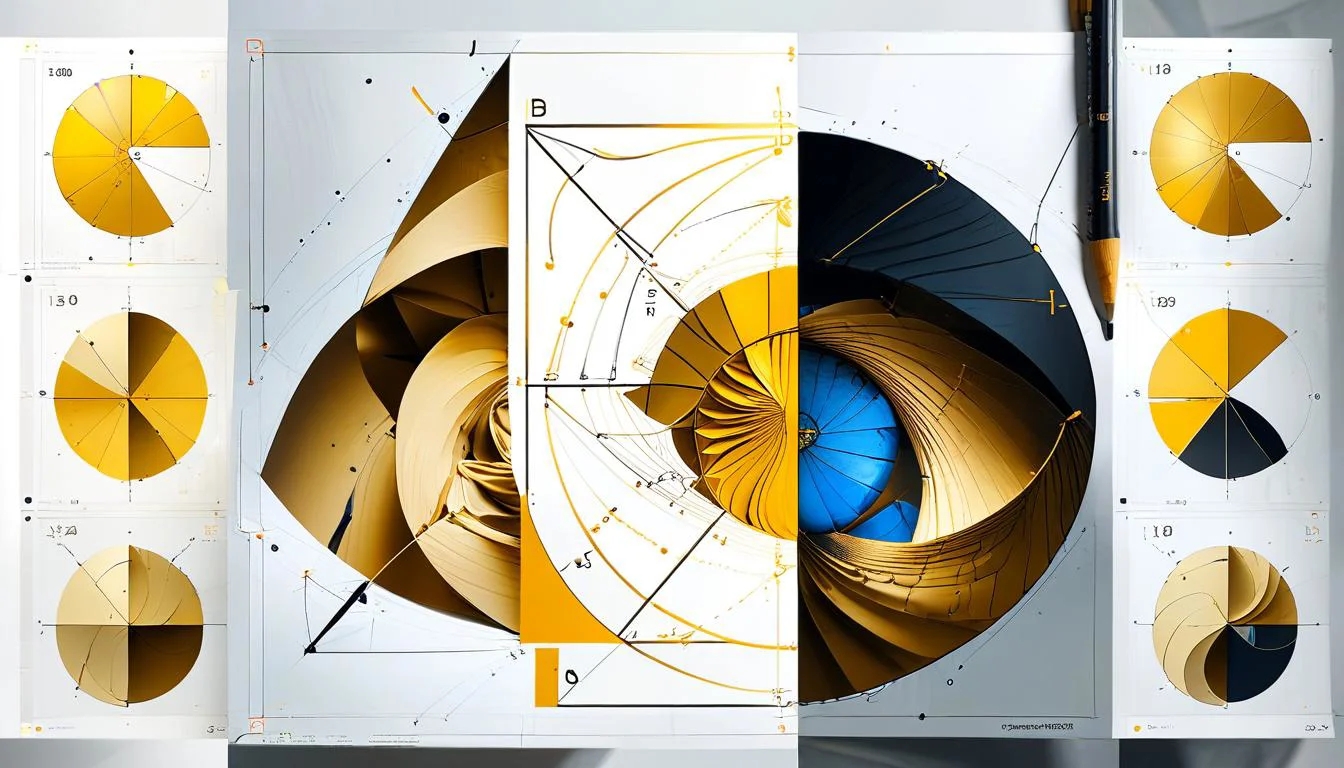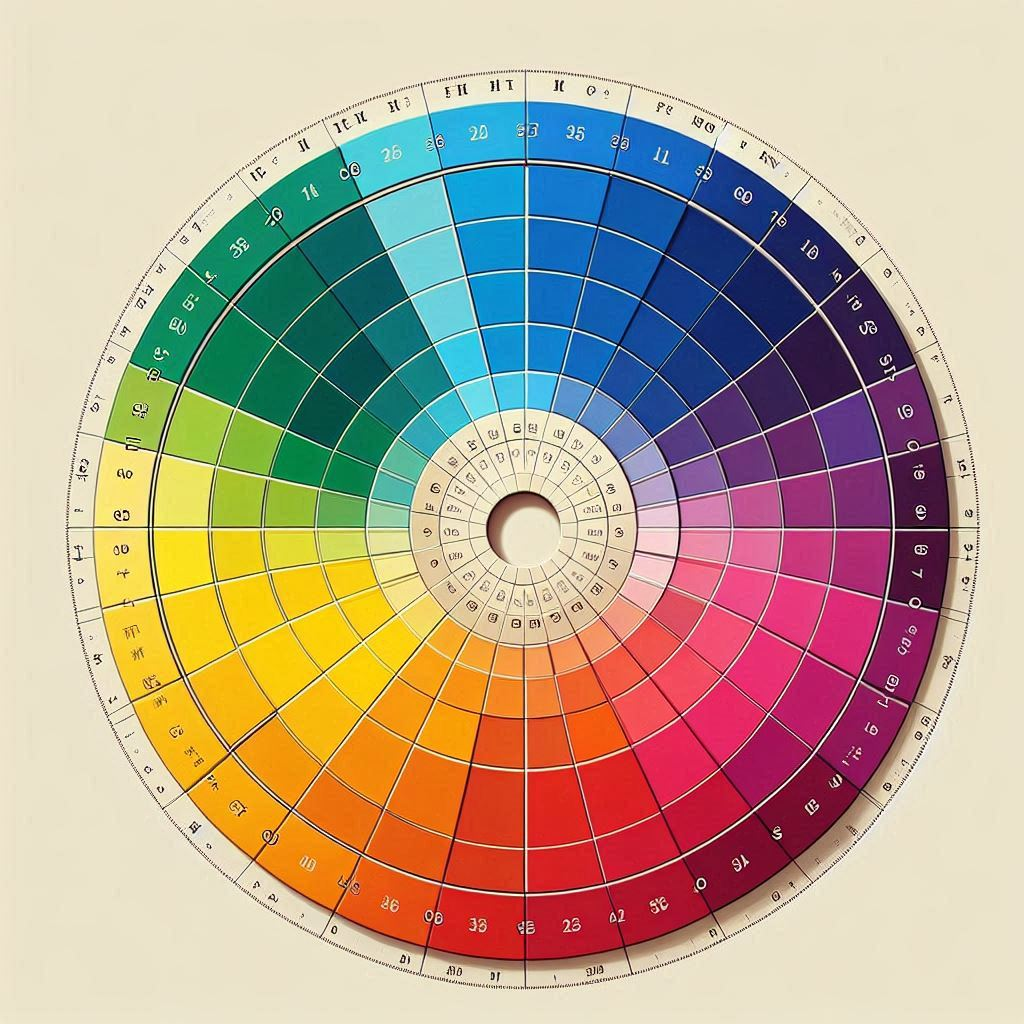The golden ratio in art, also known as the divine proportion or phi (φ), has fascinated artists, mathematicians, and philosophers for centuries. In painting, this mathematical concept has been used to create aesthetically pleasing compositions that naturally draw the viewer’s eye. Let’s explore how famous artists have incorporated the golden ratio into their masterpieces.

What is the Golden Ratio?
The golden ratio is approximately 1:1.618 and is often represented by the Greek letter phi (φ). It occurs when a line is divided into two parts so that the longer part divided by the smaller part is equal to the whole length divided by the longer part.
Tool: Golden Ratio Calculator
Enter any measurement to find the length of the part in the Golden Ratio >> Golden Ratio Tool
📘 Instructions (Click to Collapse/Expand)
Upload an image and use the tools to analyze its composition:
- Click “Select Image” to upload your artwork
- Use the checkboxes to toggle different composition guides
- Click on the image to add focal points for analysis
- Adjust the image opacity to better see the guides
Upload Image
Composition Guides
Image Opacity
Spiral Settings
Composition Analysis
Add points by clicking on important elements in your image.
Golden Ratio Tool Help: To analyze the composition:
- Observe where your focal points (pink dots) align with the Rule of Thirds intersections (red dots). Strong compositions often place key elements at these points.
- Check if important elements follow the Golden Spiral’s flow (green line). This creates natural visual movement through your piece.
- Use the Golden Rectangles (blue) to evaluate if your main subjects fit within these proportions.
Tips for artists:
- Adjust the image opacity to better see how your work aligns with these guides
- Try different spiral rotations to find natural flow patterns
- Remember these are guidelines, not strict rules – artistic intuition matters too
- Multiple focal points should create a balanced path for the viewer’s eye
In visual arts, the golden ratio is often depicted as a spiral or a series of rectangles. Artists use these shapes to guide the placement of key elements in their compositions, creating a sense of balance and harmony. There are other tools such as the “Rule of Thirds“, and we have a guide to critiquing your own paintings.
Still need some help explaining the Golden ratio in Art? Surprise. surprise! Here is a great video explanation:
The Golden Ratio in Renaissance Art
In the video above some examples were shown – here are some more details: Renaissance artists were particularly fond of incorporating the golden ratio into their works:
Leonardo da Vinci
Leonardo da Vinci, the quintessential Renaissance man, was fascinated by mathematics and its application in art. His famous painting “The Last Supper” demonstrates the use of golden rectangles to frame the central figure of Jesus and the groups of apostles.

Michelangelo
In the Sistine Chapel’s “Creation of Adam,” Michelangelo used the golden ratio to position God and Adam within the composition. The space between their outstretched fingers aligns perfectly with the divine proportion.
Raphael
Raphael’s “The School of Athens” is a masterclass in golden ratio composition. The architecture in the painting forms a golden rectangle, while the placement of key figures follows the spiral pattern associated with the ratio.

Post-Renaissance Applications
The use of the golden ratio in painting didn’t end with the Renaissance. Many later artists continued to incorporate this mathematical concept into their work:
Georges Seurat
The post-impressionist painter Georges Seurat was known to “attack every canvas with the golden ratio.” In his painting “Bathers at Asnières,” the compositional lines suggest a conscious decision to use the golden ratio as well as the rule of thirds.
Piet Mondrian
Dutch artist Piet Mondrian, known for his abstract geometric paintings, often used the golden rectangle in his compositions. His painting “Composition in Red, Blue, and Yellow” shows recurring golden rectangles, demonstrating how even non-representational art can benefit from this mathematical principle.
Salvador Dalí
Surrealist Salvador Dalí was deeply interested in mathematics and science. In his painting “The Sacrament of the Last Supper,” Dalí used the golden ratio extensively, designing the entire painting within a dodecahedron derived from the golden ratio..
The Golden Ratio in Japanese Art
The concept of the golden ratio isn’t limited to Western art. Japanese artists have also incorporated similar principles in their work:
Katsushika Hokusai
In Hokusai’s famous print “The Great Wave off Kanagawa,” the crashing waves follow the continuous arc of the golden spiral. The placement of Mount Fuji in the background also aligns with the golden ratio principles.

How to Recognize the Golden Ratio in Paintings
When examining a painting for the golden ratio, look for these elements:
- Golden Rectangles: Areas of the painting that form rectangles with a 1:1.618 ratio.
- Golden Spirals: Curved elements that follow the Fibonacci spiral.
- Rule of Thirds: A simplified version of the golden ratio, where the canvas is divided into a 3×3 grid.
- Focal Points: Key elements often align with the intersections of golden ratio lines.
The Golden Ratio in Contemporary Art
While the golden ratio may not be as explicitly used in contemporary art as it was during the Renaissance, many modern artists still find value in its principles:
- Balanced Compositions: Artists use the ratio to create visually pleasing arrangements of elements.
- Digital Art: Graphic designers and digital artists often incorporate the golden ratio into their layouts.
- Abstract Art: Even non-representational art can benefit from the harmonious proportions of the golden ratio.
Why the Golden Ratio Matters in Art
The golden ratio is more than just a mathematical concept; it’s a tool that artists use to create visually appealing works:
- Natural Harmony: The ratio is found throughout nature, making it inherently pleasing to the human eye.
- Balanced Composition: It helps artists create a sense of balance and proportion in their work.
- Guiding the Eye: The ratio can be used to lead the viewer’s gaze to important elements of the painting.
- Universal Appeal: The golden ratio transcends cultural boundaries, appealing to viewers worldwide.
Conclusion
The golden ratio has been a powerful tool in the artist’s arsenal for centuries, from the Renaissance masters to contemporary painters. By understanding and applying this mathematical principle, artists can create works that are not only visually appealing but also resonate with viewers on a subconscious level.
Whether you’re an artist looking to improve your compositions or an art enthusiast seeking to deepen your appreciation of masterpieces, understanding the golden ratio can provide valuable insights into the world of painting. As you explore art galleries or browse online collections, keep an eye out for the subtle influence of this divine proportion – you might be surprised at how often you find it hiding in plain sight.
FAQs: Golden Ratio in Art
- A mathematical ratio approximately equal to 1.618 ($\Phi$). It is defined by dividing a line so that the ratio of the whole segment to the longer part is the same as the ratio of the longer part to the shorter part.
- The Golden Ratio is also known as the Divine Proportion, Golden Section, and Golden Mean.
- The Golden Ratio is closely related to the Fibonacci Sequence (0, 1, 1, 2, 3, 5, 8…), where the ratio of consecutive numbers approaches 1.618.
- It is believed to create aesthetically pleasing and harmonious compositions.
- Artists use tools like the Golden Rectangle and Golden Spiral to guide placement and proportions.
- Examples in art include: The Parthenon, Leonardo da Vinci’s The Last Supper, and Salvador Dalí’s The Sacrament of the Last Supper.
- While it is a powerful compositional tool, it is not a mandatory rule for creating beautiful art



